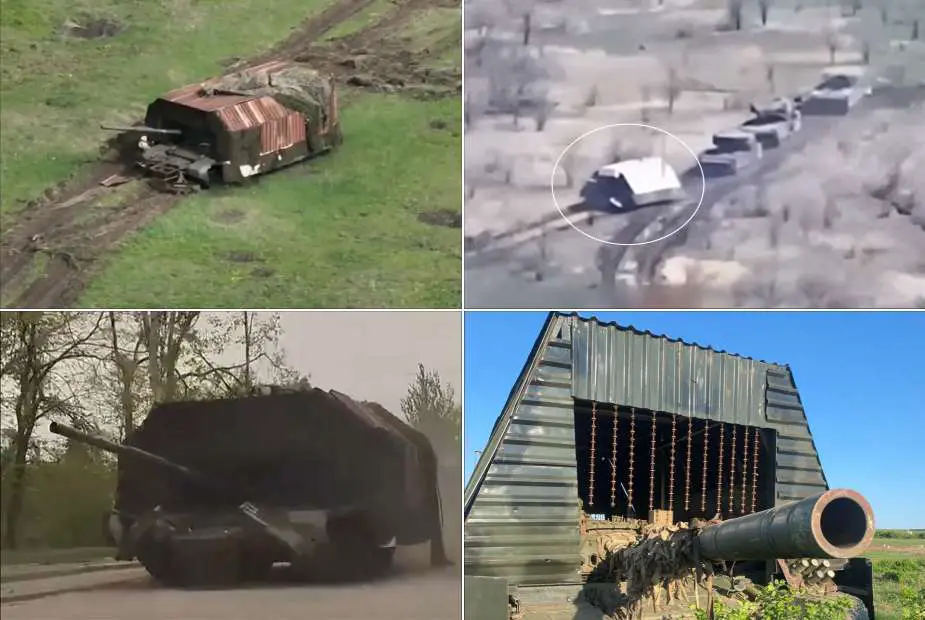Analysis: Everything We Know About Russian Turtle Tanks in Ukraine
Russian Turtle Tanks are increasingly appearing on the battlefield in Ukraine. As time passes, countless images and videos surface on social media, showing us more and more Turtle Tanks. So, how can we explain such a phenomenon, and why are the Russian armed forces equipping their Main Battle Tanks with equipment that is arguably largely superfluous? Is Russia going to start mass-producing Turtle Tanks? What is the exact role of the Turtle Tank? And who exactly uses the Turtle Tank? We will try to answer as many elements as possible in this article.
Follow Army Recognition on Google News at this link

Several examples of Russian Turtle Tanks are seen on the battlefield in Ukraine. (Picture source: Open Source Information)
First, let us explain what a Turtle Tank is. The "Turtle Tank" often refers to a modified version of the T-72 tank, developed and produced by Russia, which is equipped with "super cage armor". This adaptation aims to enhance the tank's protection against various threats, particularly drone attacks. However, this modification compromises several key functionalities of the T-72. It hinders the mobility of the turret, affecting one of the tank’s main combat capabilities. Additionally, this cage significantly increases the vehicle's weight, restricts the use of its aquatic obstacle-crossing equipment, and prevents the operation of smoke grenade launchers. These constraints drastically reduce the tank’s capabilities and, despite the intention to increase its survivability on the battlefield, they limit its versatility and effectiveness in combat.
Despite all this, some Russian media outlets highlight the "Turtle Tank" as a brilliant addition to the Russian arsenal, raising questions about Russia's intentions for large-scale military production of this vehicle. Dubbed the "conqueror of Krasnohorivka", the Russian media are full of praise for this "new" type of tank. However, recent images suggest that a Turtle Tank simply exploded on a mine near Krasnohorivka.
According to a Russian article, the Turtle Tank proved its worth during the first assault on Krasnohorivka. While the Russian article makes much of the exploits of the "Turtle Tank", it does not specify whether Russia has already started mass production. However, in the past, we have seen artisanal cage armor and then these were largely factory-produced. The Turtle Tank might follow the same path as the cage armor, especially given the enthusiasm on the Russian side. The question remains, is this a tactical response isolated or the beginning of a series of mass productions?
If the question of production is currently set aside, what exactly is the role of this tank then? Because it cannot properly fulfill the role of a Main Battle Tank.
According to Forbes, the Russian "Turtle Tank" appears to play a crucial role in breaching operations, particularly in mine clearing and penetrating enemy lines. These tanks would be designed to advance in the front line through minefields, exposed to enemy fire. According to Matthew Moss, a weapons historian, these tanks would be transformed into engineering vehicles equipped with shovels or other tools to clear mines, thus allowing the following vehicles to safely advance to enemy lines.
However, it should be noted that many Turtle Tanks that appear to us are not equipped with a mine-clearing system, so the role is not limited exclusively to mine clearing. This adaptation would make them breachers, essential vehicles for breaking enemy defenses by preparing the ground for a broader offensive, a kind of shield capable of protecting the entire column. The Turtle Tank would then have several roles: that of a shield and that of a passage cleaner.
Matthew Moss, for his part, suggests that the tank could be used for troop transport like an APC. It has been hypothesized that the sheet metal structure was built to protect troops riding on the tank’s hull. But in that case why only mount the system on assault tanks and not on Armored Personnel Carriers? Moss also points out that the Turtle Tank has two other nicknames, the "Tsar Mangal" and the "Blyatmobile". Here's a link to a very interesting article by Matthew Moss, which he updates regularly.
Then who uses these Turtle Tanks, if all have been spotted on the Russian side, it is sometimes not easy to identify the units, but here too an element of response emerges. The "Turtle Tanks" would be specifically used by the 5th Motor Rifle Brigade of the Russian army, a unit that was formerly a Ukrainian separatist group before passing under Russian command. This brigade has adopted these modified vehicles for their unique capabilities adapted to modern warfare environments, marked by minefields and heavy use of drones by the enemy.
Everything is unclear, so are we dealing with a future "game changer" or a wasted effort? Well, given the loss of the tanks' capabilities and the not-very well-defined roles of the vehicle, it appears that this vehicle is still excessively armored, thus reducing the capabilities of the Russian tanks drastically. It is unlikely to see its adoption on a national scale. It will probably remain a motivated makeshift, undoubtedly driven by the fear that UAVs and other drones bring to the Russian armed forces.
Defense News April 2024























